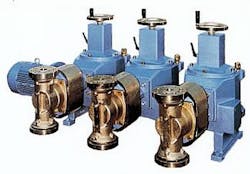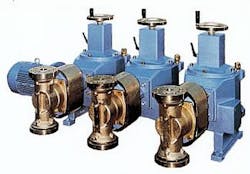Avoidance sonars available for underwater vehicles
Dolphin 6201 and 6001 obstacle avoidance sonars are available for underwater vehicles.
The 3,000 m depth-rated 6201 was developed specifically for autonomous survey vehicle pilotage and navigation. It fits into the nose cone of the vehicle and has a dual beamwidth sonar transmitter coupled with a multielement receiver and forward looking altimeter. This enab!es the instrument to perform not only obstacle avoidance but also to act in inverse mode automatically to track to a target such as a wellhead.
In obstacle avoidance mode, the 6201 scans continuously over a 90° sector as far as 200 m ahead while simultaneously identifying as many as 250 discrete sonar targets.
Each target is assigned an ID number and is monitored for range and bearing until it disappears from view.
When targets in the protected corridor in front of the vehicle are analyzed as presenting a threat, a collision avoidance message is output to the ASV's navigation computer via the Dolphin PC104 processor, a 150 by 130 by 70 mm unit housed in the pressure hull of the AUV. All raw data are stored in the processor for post-mission analysis.
In its inverse tracking mode, the sonar may be programmed to track to a target, using a combination of the sector scanning sonar and the forward looking echo sounder to home in.
The built-in altimeter also provides height-above-seabed data.
The 6201 sonar is also used on remotely operated vehicles where an Ethernet link allows the surface operator to view raw image data from each frame.
The system operates at 250 khz with a range resolution of 25 mm, angular resolution of 1.5°, and sample rate of 2 mhz. The stainless steel underwater unit's dimensions are 220 mm diameter by 142 mm, and it weighs 21.5 kg in air, 17.2 kg in water.
The 6001. The Dolphin 6001 offers real time continuous scanning over a 90° sector at 30 frames/sec.
Source: Marine Electronics Ltd., Unit 10, Barras Lane Industrial Estate, Vale, Guernsey, Channel Islands GY6 8EQ, UK.
Metering pump facilitates gas-to-liquid conversions
A full line of heavy duty plunger pumps is designed to withstand the pressure and temperatures required for conversion processes involving petroleum waxes, lubricant base stocks, and lubricants and fuel additives.
These new EH Series plunger pumps are designed to operate at pressures of as much as 1,400 psi at 750° F. and flow rates to 30 gpm, which suits them for handling liquid hot wax in gas-to-liquid conversions.
null
Featuring all stainless steel parts in contact with the molten wax material, the pumps incorporate plunger seals made from graphite with Hastelloy C sealing rings and a double extended, fully sealed stuffing box. The firm says its pumps help assure a smooth flow and provide a maximum rod thrust of 3,600 lb.
Standard features include an infinitely and linearly variable stoke length of 0-30 mm while the pump is stopped or operating, with manual adjustment using 0.01 mm vernier scale divisions, or with an electric or pneumatic actuator.
Source: American Lewa Inc., 132 Hopping Brook Rd., Holliston, MA 01746.
Licensed radio supports production uses
The 1710 Transceiver Series is a new licensed solution covering 130-174 mhz frequency ranges.
It supports oil and gas production and distribution operations. For US applications, the 1710 offers 19.2 kbps performance in 25 khz channels and 9.6 kbps in 12.5 khz channels.
Using digital signal processing, this licensed radio provides the throughput and long range synonymous with a multiple address system. The series is field configurable as a master station or remote radio, and full network diagnostics are available using this firm's InSite network management software.
This new licensed solution in the product portfolio continues to allow the company to help users who require the reliability of a dedicated frequency.
While unlicensed radios are an alternative to licensed, there are many uses that require what a dedicated frequency provides, the firm says. Licensed channels allow higher power and larger antennas to be utilized, the firm notes.
Source: Microwave Data Systems Inc., 175 Science Pkwy., Rochester, NY 14620.



